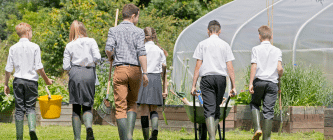Posts Tagged ‘Mental Health’
Nurturing Rutland
Nurturing Rutland
All primary school aged children in Rutland are set to benefit from training to embed a whole-school approach to nurture. The programme will empower schools to address the social, emotional and mental health (SEMH) needs and remove barriers to mainstream education for pupils with SEND.
Nurtureuk are delighted to announce that we have been commissioned by Rutland County Council to deliver the National Nurturing Schools Programme in collaboration with all of Rutland’s primary schools. The programme will support all pupils across Rutland County Council's primary schools (over 2,500 pupils) to flourish in their education.

The programme was launched in Rutland on 8th May 2024 and is being funded by the Delivering Better Value (DBV) in SEND - a Department for Education grant. Rutland County Council is the second local authority that nurtureuk are supporting under the DBV grant programme - the first being the Nurturing Solihull Programme.
Through our graduated approach to nurture, schools will be given the tools they need to provide the right support at the right time, preventing escalation of need relating to SEMH.
“The enthusiasm among Rutland’s schools for nurturing approaches has been amazing to see. I’m proud to be part of this project and it’s exciting to think about the positive impact it will have on the well being of the children across the county.” Cherida Gibson, Nurture & Outreach Lead, Rutland County Council
"I am thoroughly delighted that we will be working in Rutland to create a nurturing and inclusive environment for children and young people with SEND. The Six Principles of Nurture are at the heart of our whole-school approach to nurturing education and our team is looking forward to creating lasting impact across the 16 schools over the next year." Arti Sharma, CEO, nurtureuk.
If you’re interested in working with us, get in touch today.
Take a look at some of our other programme announcements:
Building motivation in children and young people
Building motivation in children and young people
Misbehaviour is basically a function of poor motivation, and motivation is a two-way process between the teacher and the student. McLean (2009) describes motivation as ‘the ability to cope with setbacks, adversity, pressure and power’. He describes engaged students as expressing their voice and taking the initiative, and trying to produce changes in their environment. They have a sense of being in control of their learning and the learning context. Disengaged students, on the other hand, allow external forces to control their level of engagement and motivation. In order to really understand what motivates young people, and how to maintain motivation in the classroom, there needs to be a shift away from behaviour modification and punishment towards actually understanding the individual’s needs, goals, aspirations and feelings.

Emotional intelligence
We know that there is a direct link between emotional intelligence and achievement. According to McLean (2009), emotional intelligence seems to come into play when the demands of the situation outweigh a student’s intellectual resources. Teachers need to be sure that they can and do influence a students’ ability to make use of their emotional intelligence in order to avoid future setbacks. Young people who have a fixed view of their own intelligence and abilities are particularly sensitive to failure. They tend to react defensively by withdrawing themselves from learning or not putting any effort in. They need to be reminded that their brain is actually a muscle and that it gets stronger the more it is used.
Similarly, while making sense of their progress they tend to focus on their fixed ability, and therefore don’t develop the motivational resilience that they need in order to make further progress. Optimistic students, by contrast, are more likely to think of things in terms of effort: for example, ‘I did well because I worked hard’. When they are faced with failure they will tend to look for ways to improve through more work or effort.
For the pessimistic, low emotional- intelligence level students, however, there will be a tendency to regard poor performance as being directly linked to low levels of ability. For example, ‘I can’t do this because I’m thick/stupid’ as
opposed to ‘I can do this if I ask for support and I am taught in a way that suits me’ and ‘I can also do better by putting more effort in.’

Categorising students According to McLean (2009), it is possible to categorise the majority of students as follows:
- Resilient students who are conscientious, high in emotional stability and open to experience
- Impulsive, under-controlled students who tend to be disagreeable extroverts who lack conscientiousness and emotional stability
- Cautious, over-controlled students who can show levels of emotional stability and extroversion but tend to be conscientious and agreeable introverts.
What is important in the learning context is that all such students have their basic needs of affiliation, agency and autonomy met. Self-esteem is key here as it energises, and is energised, through a sense of affiliation in the classroom. Self-belief is something that comes from a sense of agency, and self-determination is built on a positive exercising of autonomy. Simply speaking, students need to feel that they belong, that they are part of the learning context and that they have some control over it. There is a direct link between the level of control that students experience, and therefore the level of involvement they have in planning their own learning programmes, and the motivation and engagement they display.

The motivational teacher is basically someone who is dynamic and flexible and energises the student regardless of their personality or learning styles. Key to this is the ability to be flexible and not hold the reins so tightly that it takes away a student’s sense of responsibility and autonomy. Motivational teaching shares responsibility with the students and involves motivating feedback. For example, students should be praised for their effort and the way they tackle work as this makes them feel responsible for, and in charge of, their own success. Also helpful is encouraging students to become aware of the manner in which they have been clever or smart as opposed to simply pointing out that they are – this is essential as it allows for the downplaying of teacher evaluation. For example, a motivating teacher would say ‘How original is that thought, you really have worked on this and in a way that is quite unique and shows just how clever you are in your approach’ as opposed to ‘Aren’t you a clever person, look at you - you are so intelligent.’ The idea here is to encourage students to rate themselves as much as possible.
Download our free guide: The key rules for motivating students
Included in this free guide:
- 17 tips for motivating your students
- The motivational teacher is someone who is never frightened to seek feedback from the students, and to act upon it, in order to ensure that the learning context is truly inclusive and engaging. We've formulated 19 questions to illicit student views on what makes a teacher motivational
What is positive psychology?
What Is Positive Psychology?
Positive psychology has been described as a scientific study of subjective well-being. This is the technical term for what we would call ‘happiness’ and the factors that enable us as individuals in order to grow and develop and sustain ourselves in a positive manner. Key to the approach is the focus on what actually works for us as individuals, as opposed to the continual analyzing of what has gone wrong or what we are not good at. This is particularly important given the current prevalence of mental health issues amongst our children and young people.
Statistics such as this make it clear that school-based staff should focus on the development of key skills to promote resilience and happiness. Mental health should clearly be linked to, or described as, an increase in the general degree of happiness, vitality, sense of self-worth, and achievement alongside an individual’s concern and empathy for others.
Why positive psychology?
In recent years there have been a plethora of initiatives in terms of supporting the emotional wellbeing and social and emotional skills development of children and young people. There is a national recognition of the importance of wellbeing in education which has grown in recent years to the extent that all of the nations of the United Kingdom have policies and advice in place for supporting wellbeing in education.
The goal of positive psychology is basically to enhance human strengths such as optimism, courage, honesty, self-understanding, and interpersonal skills.

Positive psychology provides a means of helping the individual to use inner resources as a buffer against setbacks and adversity in life whenever these crop up. Developing such skills helps to prevent individuals from becoming depressed. As Seligman states, ‘it’s not about how to heal; it’s about to have a great life’. Seligman and his associates developed an intervention designed to instill a sense of optimism which they defined as a positive way of construing the failures and setbacks that normally occur in life.
This is similar to approaches utilised in cognitive behavior therapy in which participants are encouraged to construe failures in a more positive light. For example, if you consider that failures are stable and pervasive then they will last forever and subsequently undermine everything that you try to do – this will ultimately lead to depression. However, if we can train young people and ourselves to view such setbacks and difficulties as temporary or affecting only a small part of our lives then the depression can be averted.

This is similar to approaches utilised in cognitive behaviour therapy in which participants are encouraged to construe failures in a more positive light. For example, if you consider that failures are stable and pervasive then they will last forever and subsequently undermine everything that you try to do – this will ultimately lead to depression. However, if we can train young people and ourselves to view such setbacks and difficulties as temporary or affecting only a small part of our lives then the depression can be averted.
Why we need to prioritise children and young people’s mental health
Today is World Mental Health Day and the purpose of it is to raise the awareness of mental health and drive positive change for the future.
This annual awareness day is run by the Mental Health Foundation, the UK’s leading charity for everyone’s mental health. They drive positive change towards a mentally healthy society for all. They aim to find and address the sources of mental health problems in order for people and communities to thrive.
According to the Mental Health Foundation, “75% of children and young people who experience mental health problems aren’t getting the help they need”. This is a growing concern and it needs to be acted upon as soon as possible. The consequences of not addressing the mental health development of children and young people can extend to adulthood which can limit their opportunities of leading a fulfilling life.
Schools need to prioritise children and young people’s mental health and wellbeing, after all this is at the heart of education. Inclusive approaches to education can support pupil’s mental health and wellbeing which in turn can help to keep them in school. Increasing amounts of children are absent from school every year and we need to do all we can to get them back into school.
We recently co-hosted a panel at the Labour Party Conference in Liverpool, in which the panel discussions centred around inclusive approaches and tackling exclusions at school. The panel consisted of a great line-up of speakers, including the Chair of Commission on Young Lives; Anne Longfield, the Director of London’s Violence Reduction Unit; Lib Peck, Cabinet Member for Education; Cllr Anntionette Bramble, and our CEO Arti Sharma. It was an invigorating discussion about how nurturing approaches can positively impact pupils’ mental health and wellbeing so that they can remain in school and succeed with their education. It was recommended at the conference that more schools should adopt a whole-school nurturing approach. This can be the positive change that children and young people so desperately need.
The priority of schools should be to meet children and young people’s social, emotional and mental health needs. Many children and young people have experienced significant trauma in their lives, including bereavement, neglect and abuse, or witnessing parents experiencing mental health problems or substance abuse. All of these experiences can negatively affect their mental health. As a result, they may have difficulties with attention, learning and emotional control. These difficulties may translate into aggression, anger outbursts and challenging behaviours.
With sufficient nurture and support from adults, children can develop the skills and resilience they need to cope with stressful experiences and improve their mental health, in turn allowing them to become ready to learn at school.
To find out more about the nurturing approach and why we recommend implementing it across the whole school, please click here.
The benefits of gardening for children’s wellbeing
With National Children’s Gardening Week just around the corner, it offers the perfect opportunity to introduce some gardening activities into the classroom.
Gardening brings a whole host of learning opportunities around the core curriculum subjects of science, maths and literacy. Children can learn about the world and seasons around them while gaining a greater understanding of the journey their food takes before it reaches their plates. Gardening activities can also have a significant positive impact on your students physical, mental and emotional wellbeing.
How does gardening benefit children’s wellbeing?
Getting outside and into nature gives children the opportunity to learn in a hands-on way, encouraging them to move their bodies and develop their gross and fine motor skills; for example digging, carefully separating tiny seeds and handling delicate seedlings. Gardening encourages the use of all five senses, with sight, sound, smell, touch and taste being regularly exercised, whilst sensory gardens offer a wider range of textures, visual contrasts, and fragrances. Growing vegetables offers the added benefit of the potential to expand young palettes – children are much more likely to be open to tasting foods that they have been involved in growing and nurturing themselves.
Growing plants – caring for the seeds, providing the correct growing conditions with the right balance of light and moisture, nurturing them before results are seen – requires exercising patience, resilience, persistence and commitment. Taking responsibility for helping the plant to grow, being trusted to care for it, and helping it to thrive brings feelings of pride and empowerment. Being in nature has a calming effect, and gardening has been shown to reduce stress levels, improve mood and enhance self esteem. Gardening actually makes you happy! Mycobacterium vaccae, which is found in soil, increases serotonin produced in the brain, which in turn helps to regulate anxiety.
As both a group activity, social skills are developed through team or partner work, and sharing, turn taking and respect will be required. Growing a garden offers the opportunity to advance self esteem and self motivation, and children who practise gardening at school have been shown to display increased empathy, both to the world around them and to their fellow students.
A study by Frontiers, where the behaviour of a group of 11-12 year old students was observed within the classroom and within the school garden, concluded that students showed more socially competent behaviour in school garden lessons than in classroom lessons.
How can I bring gardening into my setting?
Whilst growing a full garden can be a huge but immensely rewarding commitment, there are other ways to bring gardening activities to your setting. Gardening activities can begin inside, and if you are growing vegetables, you’ll enjoy the added benefit of being able to incorporate them into a snack time activity at a later date! Options with faster results can help to keep interest, especially for younger children.
It could be as simple as regrowing vegetables from scraps – celery, lettuce, and spring onions all regrow well and quickly when you place their bulb stem resting on top of a bowl of water.
Sunflowers, broad beans and peas are all grown from seeds and are easily germinated indoors. They can then either be sent home in cups of soil or planted into an area at school to watch them grow. Our emotional egg heads activity sheet offers another simple suggestion to start a simple gardening activity in the classroom.
Both tomatoes and strawberry plants are great fun to grow from a slice of the fruit itself – place a slice with plenty of seeds into some soil, place on a warm sunny windowsill and watch and wait for each seed to grow into a plant that could potentially produce dozens of new fruits! Both grow well in containers, or even hanging baskets, so are a great option when space is limited, and strawberries have the added benefit of coming back each year too.
If you’re able to dedicate time, space and budget for bigger projects, a vegetable patch or sensory garden are great places to start. Community requests for spare tools, outdoor clothing or seeds can prove useful for starting a gardening club or outdoor nurture space. Local garden centres, supermarkets or allotment associations are often keen to support schools in getting started.
The impact of nurturing activities like gardening can be huge for students’ social, emotional and mental wellbeing. One nurture teacher from the South-East of England recently took their nurture group to complete a two-day gardening project in a local primary school: “Every child I teach could exceed their flightpath, and that still wouldn’t come close to making me as proud as I was at the end of those two days. Each and every one flung themselves into it, working together as a team, taking turns, and supporting each other. I didn’t see a single phone or headphone all day, which with our lot is a genuine measure of success, until the end of the day when they took pictures to show their mums. There aren’t any words to adequately express how that made me feel.”
For more information on how you can bring nurturing activities and interventions into your setting, please visit our website.
Further reading:
- RHS Campaign for School Gardening
- Garden Organic school gardening resources
- Learning Through Landscapes outdoor learning ideas
- Groundwork funding opportunities
- Edina Trust funding opportunities
Supporting children and young people with anxiety
Anxiety disorders are one of the most common mental health problems, and they are thought to affect up to 19% of children and young people across the UK. They affect people both physically and emotionally, and can make children feel panicked, scared or even ashamed. Anxiety disrupts children and young people’s development, and their ability to build relationships and access education.
More and more children are arriving at school distracted and distressed – if they arrive at all. Severe absence has soared by 134% compared to pre-pandemic levels, and more than a quarter of all children now regularly miss school (Lost and Not Found report, March 2023).
Today marks the beginning of Mental Health Awareness Week run by the Mental Health Foundation, and this year’s theme is anxiety. The awareness week encourages people to share their own experiences, alongside ideas or strategies they use to manage their anxiety.
It is crucial that we provide effective support for children and young people that struggle with anxiety so that they can thrive in education and live happy, healthy lives.
Children and young people facing mental health problems such as anxiety often struggle to engage with mainstream education. They may be withdrawn and isolated, or display hugely challenging and disruptive behaviour that significantly affects those around them. Teachers need support to create safe environments that enable pupils to develop the confidence and resilience they need to succeed both academically and in life.
One of the Six Principles of Nurture is to offer a safe base. Whether this be a dedicated nurture room or mainstream classroom, the environment should be a warm and inviting space that helps children and young people to feel calm and ready to learn. It is vital for staff to be reliable and consistent in their approach to children, modelling positive relationships with each other and the children and young people.
Nurture rooms often have quiet zones or comfy areas that reflect a home. Nurture groups are designed to address children’s social and emotional needs, enabling them to better manage their anxiety. When pupils feel safe in the nurture group and in school, they are able to enjoy school more and this can have a positive impact on their school attendance.
Throughout this week, we’ll be sharing a range of advice and tips to help support children and young people to manage their anxiety. Be sure to follow us on Facebook, Twitter, Instagram or LinkedIn to access the resources to enable all children and young people to gain the education they deserve.
The Boxall Profile® – A whole school approach to supporting pupil’s mental health
The Boxall Profile® is an invaluable resource for the assessment of children and young people’s social, emotional and behavioural development. It provides educators with a precise picture of a pupil’s strengths, as well as difficulties which could affect their learning. The Boxall Profile® is used by over half of UK schools that assess their pupils’ mental health.
How can the Boxall Profile® help children and young people’s social, emotional and mental health?
Children and young people facing social, emotional or mental health challenges often struggle to engage with mainstream education. They may be withdrawn and isolated, or display hugely challenging and disruptive behaviour that significantly affects those around them. One of the Six Principles of Nurture is that all behaviour is communication and so disruptive behaviour at school is a child’s way of communicating that they have unmet needs.
The Boxall Profile® is a way of understanding what lies behind pupils’ challenging behaviour to detect any unmet social, emotional and mental health needs. Once social and emotional needs are identified, education professionals can put in place targeted support to help children and young people develop those skills, and this in turn will help to improve their behaviour, mental health and wellbeing.
By using the Boxall Profile®, teachers can adopt the following strategies to help improve children and young people’s social, emotional and mental health:
- Giving pupils the opportunity to practise their social and emotional skills – for example by encouraging them to work in pairs and groups.
- Making time for social-emotional learning, either during targeted PSHE lessons or by embedding it throughout the curriculum.
- Modelling good social and emotional skills themselves, when interacting with pupils and other staff members.
The Boxall Profile® allows teachers to develop an inclusive, whole class approach that enables them to access all their pupils, by removing individual barriers to learning.
Boxall Profile® and the graduated approach to nurture

Our graduated approach to nurture ensures that every child in a school has the opportunity to flourish in their education. It ensures that every child has access to the support they need, when they need it. We work to measure and support the social, emotional and mental health of all children using the Boxall Profile®, so no child falls through the cracks.
The Boxall Profile® is an essential part of the graduated nurture approach and sits across all tiers of the nurture pyramid. The Boxall Profile® is crucial to determine what level of support the pupil needs to receive: whether the child will require access to a targeted intervention such as a nurture group, or whether other nurturing interventions such as attending a lunch time group/ afternoon club may be sufficient.
We recommend that all schools and educational settings identify the social, emotional and mental health needs of all their pupils using the Boxall Profile®, to ensure that all needs are recognised and can be supported through early interventions.
To get started or for more information about the Boxall Profile®, please take a look at our website.
Making mental health and wellbeing for all a global priority
Today is a very important awareness day, World Mental Health Day, which takes place on the 10 October every year. It is run by the Mental Health Foundation and this year’s theme is to ‘make mental health and wellbeing for all a global priority’.
It is vital that we all look after our own mental health and wellbeing, as well as supporting others with theirs. There has been a global mental health crisis since the Covid-19 pandemic, with people of all ages becoming increasingly anxious and stressed. According to the World Health Organisation (WHO), there was a 25% rise in anxiety and depressive disorders during the first year of the pandemic. They also stated that there has been a severe disruption in mental health services. The need to nurture our wellbeing and prevent the escalation of more complex mental health problems has never been more apparent.
Here at nurtureuk, we are dedicated to improving the social, emotional, mental health and wellbeing of children and young people. Numerous research reports, including papers in the International Journal of Nurture in Education, have provided evidence of the positive impact that nurture principles and practices have on children and young people’s mental health and wellbeing. Embedding the Six Principles of Nurture within a school environment and developing an inclusive whole-class approach enables teachers to support all their pupils by removing individual barriers to learning. This can help to make pupils feel safe at school and to be able to get on with other pupils, as well as boosting their mental health and wellbeing by developing their confidence and resilience.
There are many ways to support children and young people’s mental health and emotional wellbeing in the classroom. Some of these strategies include:
- Making time for social-emotional learning, either during targeted PSHE lessons or by embedding it throughout the curriculum.
- Giving pupils the opportunity to practice their social and emotional skills – for example by encouraging them to work in pairs and groups.
- Teachers modelling good social and emotional skills themselves, when interacting with pupils and other staff members.
- Monitoring the social-emotional wellbeing of the whole class, using assessment tools like The Boxall Profile®.
Implementing a whole-school approach to nurture is the best way to support and improve the mental health and wellbeing of all pupils and staff in a school. Our National Nurturing Schools Programme supports schools to identify children and young people who need additional, more focused support through nurturing interventions, or as part of a nurture group. Teachers can help pupils to develop the social skills they need to thrive and ensure that their needs are met. It’s vital that schools are committed to supporting all their children and young people to achieve their very best and to make their mental health and wellbeing a main priority.
This World Mental Health Day we can all play a part in helping to increase the awareness of mental health and how crucial it is to manage our own mental health and to support others with theirs. Mental health and wellbeing needs to be prioritised all around the world for people of all ages. The rise in mental disorders is a global concern, and it is only together that we can put the right support and interventions in place to help ourselves and others.
Supporting children and young people with stress at school
Stress is a normal response to changes and challenges, and it is an inevitable aspect of life. For children and young people, they can feel stressed when there is something that they need to prepare for or adapt to. Building up children and young people’s resilience is key to helping them deal with stress and other overwhelming emotions.
This year’s Stress Awareness Month focuses on community; highlighting how a lack of support can lead to loneliness and isolation among individuals. Social isolation in particular can have a detrimental effect on both children’s mental health. This is why it is crucial that children develop the basic social skills needed at an early age to interact with other pupils and staff so that they can create positive and meaningful relationships. These are skills that children can continue to use and develop later in life to ensure that they remain socially active and avoid any feelings of isolation or loneliness.
A great way to help children and young people to develop their social skills is by introducing nurture provisions at school. In nurture groups for example, there is a special emphasis on language and communication, and they are designed to help children develop vital social skills, confidence and self-respect. Nurture groups cater for early years, primary or secondary school pupils with social, emotional and behavioural difficulties which make it harder for them to learn in a mainstream classroom.
Nurture groups enable children to develop the ability to regulate or manage their feelings and, in particular, the stresses that are often related to or emanate from angry feelings. The support activities offered through nurture provision allow children to relax, express their feelings and communicate with others, all of which help them to cope with stress. The 60 Mindful Minutes resource by Dr Tina Rae provides a variety of fun and engaging activities that can be used in nurture groups. This practical resource helps children to soothe and calm themselves by learning mindfulness, which can boost children’s mental health and happiness.
Nurture provisions also allow practitioners to get a more accurate understanding of what levels of stress children experience so that they know what adaptive coping strategies can be implemented. The Boxall Profile® Online helps practitioners to recognise children’s stress triggers and responses, so that they can identify the right level of support that each child needs in the nurture group or classroom. Using the Boxall Profile® is a great way to identify and address hidden issues such as stress, so that practitioners can spot issues sooner and reduce their impact on children and young people’s learning.
By introducing nurture provisions in your school, and analysing pupil’s behaviour using the Boxall Profile®, you can support children and young people with managing their stress levels by allowing them to develop the social emotional skills, resilience and positive behaviours they need to do well in school and in life.
How to Support Children with their Mental Health
This week, we’ve joined with charities, schools, parents and educational professionals across the UK to support Place2Be’s Children’s Mental Health Week. Around 50% of people who have lifetime mental health problems first experience symptoms by the age of 14, and the awareness week has highlighted the importance of providing support early on in life.
This year’s theme of #growingtogether encouraged people to share stories of how they have grown, and who helped them along the way. It helps us to celebrate people like Robin Lee, founder of Wilds Lodge School in Oakham, whose passion to see every child flourish with their education led to many of his pupils with social, emotional and mental health (SEMH) difficulties receiving the support they desperately needed.
Robin, like many other education professionals, championed the nurture approach to improving the mental health of his pupils. Here at nurtureuk, we’ve made it our mission to improve the social, emotional, mental health and wellbeing of all children and young people across the UK.
Through our graduated approach to nurture, we ensure that every child in the school has the opportunity to flourish in their education, and has access to the support they need, when they need it. Whether they enter the education system with early childhood trauma, or experience it during their time in education, we work to support the social, emotional and mental health of all children, so no child falls through the cracks.
Children’s Mental Health Week has emphasised the importance of providing this crucial support for children and young people. But how do we know if the support is working? How do we measure the improvement in their social, emotional, mental health and wellbeing?
The Boxall Profile® Online is an assessment tool that enables staff to assess and track the social, emotional and behavioural development of children over time. It provides staff with an overview of the needs and how to respond to them – both in the classroom and with specific nurturing interventions.
The unique tool supports staff to develop their observational skills to include early identification of difficulties, and provides the opportunity to create individualised targets and interventions, as well as practical strategies and techniques for the classroom to help children and young people achieve their full potential.
The Boxall Profile® is now used by over half of UK schools that assess their pupils’ mental health. To find out more, please visit www.nurtureuk.org/what-we-do/the-boxall-profile.











